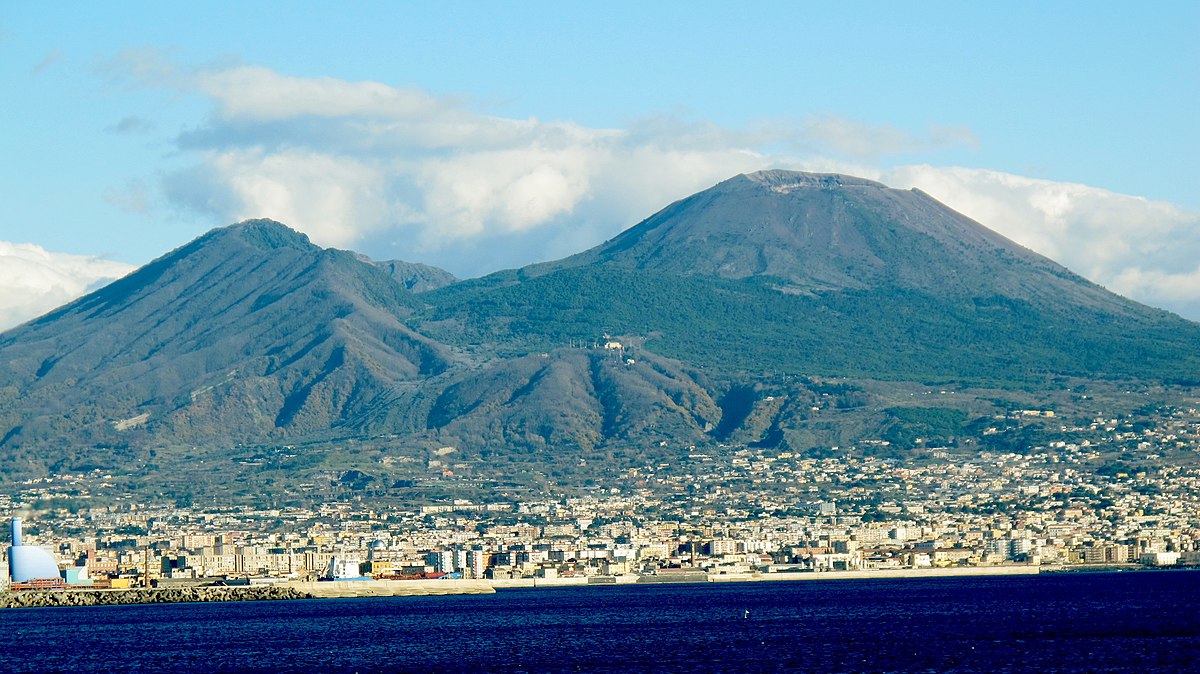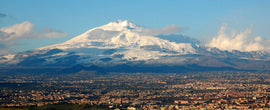CAMPANIA
As we have learned from many visits here in IWC, when it comes to vino-spewing volcanoes, Mt. Etna in Sicily tends to attract the most oxygen, not just in terms of Italy, but Europe too, and even the whole rest of the world. This makes some sense: there may be more active Mts. BOOM! on the planet (if only a few), but none clear near as much fermented grape juice.
But Etna’s centrality qua oenology tends to obscure the extent to which the rest of the Apennine Peninsula anchors a veritable Mediterranean Ring of (the fancy and mild kind of) Firewater. For instance, did you know that there is an island in the Aeolian archipelago north of Sicily that’s actually called Vulcano? Also known as “the Gates of Hell” in ancient times, and so named originally b/c the Romans thought it the chimney of Vulcan, their god of fire. It is, as you might have guessed, where the word volcano comes from.
That place has been dormant since 1888 and, to my knowledge, they don’t make wine there (only 450 residents), but its Aeolian sibling Stromboli has been erupting for so long - 2,000 years - it is nicknamed “Lighthouse of the Mediterranean.” There is some wine made there apparently (future club material?) though the major viticulture hot spot in the chain is Salina which, of course, also has volcanoes.
And that’s just the islands. Moving to the mainland gets us to Campania, our May destination, which boasts the dormant-portent Campi Flegrei (Fiery Fields) to the west of Naples, quiet for now but apparently worth keeping an eye on. Then of course, there’s Vesuvius. Infamous for destroying the Roman cities of Pompeii, Herculaneum, Oplontis and Stabiae in 79 AD, it remains the most active volcano on the European continent (it’s the only one to have erupted in the last 100 years), and one of the most hazardous anywhere, due to the fact that 3,000,000 people live near enough to be affected by an eruption, with at least 600,000 in the danger zone.
So there is a good reason why less viticulture gets attempted on its slopes - it’s dangerous! - which makes it only right we recognize the efforts of anybody intrepid enough to plant despite the risk. Massimo Setaro has made it his mission to showcase the mountain’s unique attributes, starting with an obscure white grape called Caprettone, which takes its name from the fact that Vesuvio’s vineyards face the tiny island of Capri to the west. Only identified as a separate varietal in 2014, it is at the heart of Massimo’s project, and in his hands achieves a dynamic combination of ripe, round fruit and vigorous acidity, underpinned by a smoke-salt interplay that reflects its very specific provenance.
The red is made from the Aglianico grape, which arguably remains Campania’s calling card. Full bodied and late ripening enough that it cannot be grown any farther north, Aglianico is sometimes known as the ‘Barolo of the South’ due to its elegant tannins and aging potential. Indeed, Irpinia, the east-central area of Campania near Avellino where this month’s selection is grown and made, has weather, terroir and vegetation very similar to Piedmont, Barolo’s home in the North. Taurasi is the DOCG within Irpinia practically synonymous with Aglianico (though Aglianico di Vulture, from the bordering Basilicata region is also great.) This bottling, from the great I Favati winery (select as one of Wine & Spirit Magazine’s top 100 in 2023) is 100% Aglianico from declassified Taurasi fruit, robust and age-worthy but with a freshness compatible with whatever version of summer the Bay is gonna offer us this year.
Salut,
Alan Hicks - Wine Buyer, Noe Valley
|
Casa Setaro ‘Munazei’ Lacryma Christi del Vesuvio Bianco |
|
|
Region: Lacryma Christi del Vesuvio DOC |
About the Winery: The wines of Vesuvio have a long and storied history, but local specialties like the dramatically named Lacryma Christi del Vesuvio (“Christ’s Tears on Vesuvius”) have fallen into relative obscurity in recent decades. Massimo Setaro is seeking to transform the zone’s reputation and bring the wines of Vesuvio the modern-day recognition he feels they deserve. Heir to the renowned Setaro pasta-making enterprise, fourth-generation Massimo founded Casa Setaro in 2004, beginning with his family’s small pre-phylloxera holdings around their hometown of Trecase on Vesuvio’s southern slopes. Massimo has since planted new parcels, and today the estate totals 12 hectares–notably, of exclusively own-rooted plant material, as this zone’s unforgiving volcanic sand is inhospitable to phylloxera. He works only with indigenous varieties: Piedirosso and Aglianico for his reds; and, while he does grow terrific Fiano and Greco, the characterful and hyper-local Caprettone is what drives his imagination and forms the basis of his most distinctive white wines. About the Winemaking: Manual selection of the grapes, destemming and draining span, of the flower must, fermentation at controlled temperature for about 20 days In steel for 6 months and for 2 months in the bottle. Tasting Notes: Aromas of citrus, tropical fruit, crushed stones. Weighty and concentrated, yet balanced; a vibrant, mineral core. |
|
Winemaker: Massimo Setaro |
|
|
Price per bottle / per case $25.99 $280.70 |
|
|
Suggested Food Pairing: Neapolitan Pizza Margherita, seafood fritto misto, crudo of salmon with orange and lemon. Spaghetti w/ white clam sauce |
|
|
I Favati Irpinia Campi Taurasini ‘Cretarossa’ 2017 |
|
|
Region: Irpinia DOC |
About the Winery: The I Favati winery has been recognized as one of the outstanding Italian producers of fine wines and grappa. Passion, and a culture of good wine, are a tradition that has been carried on by this great family since the early decades of the last century. Located in Irpinia, famous for its beauty, its rich volcanic soil, and its wine, the company is expertly managed by winemaker Rosanna Petrozziello, her husband Giancarlo Favati, her brother-in-law Piersabino Favati, and daughter Carla Giusy Favati. This dynamic family, along with enotechnico, Vincenzo Mercurio, handle every aspect of this family business, managing the vineyards, the harvest, the production and marketing. Their vineyards are located within the Fiano di Avellino, Greco di Tufo and Taurasi DOCG zones. All together they have 16 hectares of Irpinia’s unique, indigenous, grape varieties. The cellar is equipped with the most advanced winemaking technology, complementing the careful work in the vineyards. Rosanna oversees each stage of the process assuring the best outcome of each cycle to guarantee the high quality of all wines produced. About the Winemaking: I Favati are practicing organic. They only intervene in the vineyard when necessary and even then will spray with copper or sulfur, organic approved chemicals that help prevent fungus and rot. The grapes go directly to press after picking and are pressed in an anaerobic (no oxygen) environment, the wine is fermented at low temperatures and without the presence of oxygen (keeping oxygen from contacting the wine is a difficult process and expensive, which is why conventional winemakers use additives so they do not have to worry as much about keeping the O2 out). They use 2g of Sulfur per quintal of grapes (~200lbs). They do not add anything else to the wine. There is no fining or filtration, only racking, which is the process of keeping the wine at cool temperatures and letting the sediment fully settle before simply draining the wine off. The small annual production between 40,000 and 50,000 bottles reflects their mission to achieve the highest quality rather than the largest quantity. Elevation: 450-500 meters (1,480-1640 feet) above sea level. Clayey soils in hilly terrain. 15 and five years old and 5 years old vines planted in the Guyot system. 8,000 kg (about 3.2 tons per acre) Harvest date: First 10 days of November. Tasting Notes: Concentrated aromas of pepper, black cherry, anise, and oak. On the palate the wine denotes concentrated fruit, good acidity, alert and enjoyable tannins. |
|
Winemaker: Rosanna Petrozziello |
|
|
Price per bottle / per case $32.99 $356.30 |
|
|
Suggested Food Pairing: Tagliatelle with bread crumbs; roast lamb; semi aged cheese; Salumi Fusilli giganti con noci, salsiccia e pomodorini (see recipe) |
|
Fusilli giganti con noci, salsiccia e pomodorini
(Large fusilli pasta with walnuts, sausages and cherry tomatoes)
This recipe from Avellino province works all year around. The walnuts impart a nutty earthy flavor that really compliments the I Favati Cretarossa.
Ingredients (serves 4)
• 8 oz. Fusilli
• 8 walnuts, no shell, chopped
• 2 Italian pork sausages, cut in rough pieces and with the case removed
• 5-6 cherry tomatoes, each one cut in four pieces
• 2 tbsp. extra virgin olive oil
• 1 small yellow onion, thinly sliced
• 1 tsp. crushed chili pepper
• 1⁄2 cup dry red wine
• Salt & pepper
• 1⁄2 cup grated Auricchio* cheese
Instructions:
- In a medium size sauté pan heat olive oil then add the onion and the chili pepper
- Sauté the onion until golden with the chili pepper on medium-low heat flame
- Add the chopped walnut, cover the pan, lower the heat and cook for about 5 minutes to help the walnuts to release their own oil
- Uncover the pan, add the sausages and raise the flame to medium heat to cook until the meat is seared evenly
- Add the wine and let it reduce then lower the flame again
- Meantime in a large pot bring the water to boil, add 1 Tbsp. of coarse salt and drop in the pasta
- 5 minutes before the pasta is ready add the cherry tomatoes to the sauce and cook on medium-low heat until the pasta is ready
- Serve with a sprinkle of Auricchio cheese
* Gennaro Auricchio created Auricchio cheese in 1877 in Napoli. It can be made with sheep or cow milk. When aged, the taste is similar to provolone cheese.





